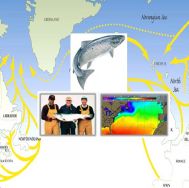SalmoGlob
 |
Modelling Atlantic salmon population dynamics and improving stock assessment for all stock units in the North Atlantic: a large scale approach to unravel the fingerprints of global changes |
|
Research
Context and Issues
The project lies in the context of the worldwide decline in the Atlantic salmon population. The working hypothesis is that this decline is a response to major changes in the North Atlantic ecosystem (e.g. temperature, trophic conditions) that influence populations during marine migration and/or around marine feeding grounds (e.g. West Greenland). However, underlying ecological and demographic mechanisms are largely unknown, and models should be developed to suggest management strategies that account for these recent changes in marine productivity. The project seeks to strengthen the scientific basis of assessing Atlantic salmon stocks at the international level. Research aims to improve the modelling framework of the ICES Working Group on North Atlantic Salmon (ICES WGNAS) and will contribute to the management plans proposed by the North Atlantic Salmon Conservation Organization (NASCO).
Objectives
Objectives are twofold:
(1) The SalmoGlob research project seeks to improve understanding of demographic and ecological mechanisms that drive population dynamics at the North Atlantic scale. In particular, the project aims to illustrate effects of changes in the marine ecosystem on the productivity and functioning of the Atlantic salmon life cycle.
(2) From an operational perspective, the SalmoGlob project aims to improve stock assessment methods used by ICES WGNAS to quantify changes in marine productivity and to take these methods into consideration in scientific recommendations so as to develop adapted management options in a probabilistic framework that complies with the precautionary principle.
Methodology
We will develop age- and stage-based population dynamics models using a hierarchical Bayesian approach (HBM) that can integrate population models within a statistical approach to assimilate multiple sources of information and data.
Population models will be developed at the scale of all stock units defined by ICES WGNAS in Southern Europe and North America. Models will use time-series data (estimates of returns, catches at sea) compiled by ICES WGNAS for all stock units from 1970-2016. Modelling Atlantic salmon population dynamics at the scale of its distribution area will allow (i) separating effects of environmental factors from effects of mixed-stock fisheries in a hierarchy of spatial scales (local effect associated with each stock unit and global effect shared by all populations) and (ii) better understanding of mechanisms that control changes in key life-history traits during the marine phase (marine survival and probability of maturing after the first year at sea).
Building models within the HBM framework will also allow us to assess the influence of various scenarios (e.g. fisheries management and/or climate change) in a probabilistic framework that complies with the precautionary principle.
Expected Results
(1) A flexible modelling framework for Atlantic salmon population dynamics at the North Atlantic scale to quantify and analyze non-stationary life-history traits in a context of global changes.
(2) Better understanding of factors that control population dynamics at the North Atlantic scale. In particular, better understanding of demographic and ecological mechanisms underlying changes in two key marine life-history traits (marine survival and probability of maturing after the first year at sea).
(3) Transfer of the modelling approach to operational tools for stock assessment and management, in close collaboration with ICES WGNAS.
Publications issued from the project
RIVOT, E. OLMOS, M. CHAPUT, G. PREVOST, E. (2019) .Hierarchical life cycle model for Atlantic salmon stock assessment at the North Atlantic basin scale
OLMOS, M. MASSIOT-GRANIER, F. PREVOST, E. CHAPUT, G. BRADBURY, I. R. NEVOUX, M. RIVOT, E. (2019) .Evidence for spatial coherence in time trends of marine life history traits of Atlantic salmon in the North Atlantic
OLMOS, M. (2019) .Investigating the drivers of Atlantic salmon populations decline across the North Atlantic basin
RIVOT, E. OLMOS, M. (2018) .Modelisation de la dynamique des populations de saumon et transfert vers des outils d?evaluation des stocks dans un contexte international
MASSIOT-GRANIER, F. PREVOST, E. CHAPUT, G. POTTER, T. SMITH, G. WHITE, J. MANTYNIEMI, S. RIVOT, E. (2014) .Embedding stock assessment within an integrated hierarchical Bayesian life cycle modelling framework: an application to Atlantic salmon in the Northeast Atlantic
MASSIOT-GRANIER, F. (2014) .Dynamique des populations de saumon atlantique (Salmo salar) a l'echelle de son aire de repartition : separer les differentes echelles dans les facteurs de forcage par une approche de modelisation hierarchique bayesienne
FAVREAU, A. (en cours) .Reponse des populations de saumon atlantique aux changements de l?ecosysteme marin. Separer les composantes heritable et plastique de la variabilite temporelle de l'age a maturation
People involved
 |
DUBOST Gaspard, Scientist Phone : +33 2 28 48 55 57 Email : gaspard.dubost@institut-agro.fr |
 |
ELIOTT Sophie, Scientist |
 |
LEBOT Clément, Scientist Phone : +33 2 23 48 56 72 Email : clement.lebot@institut-agro.fr |
 |
NEVOUX Marie, Scientist Phone : +33 2 23 48 50 15 Email : marie.nevoux@inrae.fr |
 |
PATIN Rémi, Scientist |
 |
RIVOT Etienne, Scientist Phone : +33 2 23 48 59 34 Email : etienne.rivot@institut-agro.fr |
Partners
Funding and Support
AFB, Ph.D. Research Fellowship, University of Rennes
